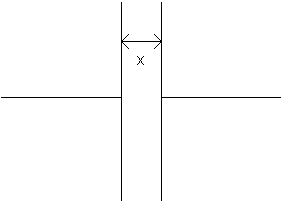| Ch26 | 11 | 12 | 13 | 21 | 25 | 34 | 35 | 36 | 37 | 43 | 59 |
Thank God for yellow !! |
|||||||||||
| Chpt.
Summary: A. C = Q/(V+ - V-) Parallel plate (derive this !): Cylindrical (derive this !)
Spherical (derive this !)
B. Energy density (energy/volume) in a region of space with E: C. Energy of a capacitor: The energy of a capacitor can heat up objects. See #37 and the Sample Test 3. D. Dieletric materials with k > 1 increase the capacitance. See # 43. E. |
|||||||||||
| 11. (a) Derive the capacitance C of this system. Read example 26.2. (b) C = Q/(V+ - V-) . See your class notes! I derived this. Solve for V+ - V- . |
|||||||||||
| 12. See equation 26.6 in example 26.3 . Note that b = 2a in this problem. Substitute b = 2a in equation 26.6. Set this expression equal to 20.0 µF. Solve for the two radii a and b. Then find the volume of a shell of thickness b - a. Here is how you do that: First, find the volume of a sphere of radius b. Second, find the volume of a sphere of radius a. Then subtract the second volume from the first volume. | |||||||||||
| 13. Guess what? This problem is
almost identical to problem 2 of sample test 2. Click here
and scroll down to review it. In both cases, the electric field is constant and
horizontal. In this case, V + - V- = Ed so that E = ( V + - V- )/d . Use this expression for E and follow the same method as problem 2 of sample test 2 to find E and then solve for ( V + - V- ). Note you can also read example 23.4 in Ch. 23 for some of the "flava" associated with this problem. |
|||||||||||
| 21.(a) Let 15µF = C1
and 3.00 µF = C2. These two capacitors are in series, so Cs
= C1*C2/(C1 + C2) . Now, Cs
is in parallel with C3 = 6.00 µF. Thus, we can combine them as so: Cp
= Cs + C3 . Finally, Cp is in series with C4 = 20.0µF. Do you know how to combine Cp and C4 in series to get the final expression Cf for the equivalent capacitor? I'm sure you do. (b) The charge on Cf is Qf = 15 Volts/Cf . This also is the charge on C4 because that capacitor is in series with Cp. The next step is to find the charge across C3. That's easy. The total voltage of 15 Volts is the sum of the voltage across C3 and the voltage across C4 : 15 Volts = Q3/C3.+ Qf/C4 . Solve for Q3. Finally, you can find the voltage across C1 and C2. The voltage across the series combo of C1 and C2 is Q3/C3 since the series combo is in parallel with C3. Thus, the charge across both C1 and C2 is Cs* Q3/C3 . |
|||||||||||
| 34. You should read page 815
for the low-down on energy density. The derivation is easy. Use the fact that the
energy of a parallel plate capacitor is U = ½CV2 .
Then, use the fact that V =Ed and use the expression for C in equation
26.3. Then divide by the volume Ad of the space between the plates to get that the
energy density (in J/m3 ) is
To solve this problem , use the fact that uE*(volume) = 1.00x10-7 J. Solve for the volume in m3 and liters. |
|||||||||||
| 35. We should do 35 first, since
the result will be applied to 25. Let's write down the potential energy of the parallel
plate capacitor: where,
Thus, We see that as the coordinate x, the separation between the plates, increases, the
potential energy increases. Think of the gravitational potential energy near the surface
of the earth: Well, just as in the gravitational case, we get: |
|||||||||||
| 25. After thinking about , we can
approach 25 with greater clarity. (a)
(b) Here, x is the distance that one spring stretches. What is x? Think about it. If the distance between the plates decreases from d to d/2, then what is the distance that one spring stretches ? Note that Q2 = C2V. Solve for k. |
|||||||||||
| 36. Let Q = the charge on
plate a. Thus, from Chapter 23: Fx =QE The force points in the positive x-direction. E =
the magnitude of the electric field caused by the negative charge on plate b. From Chapter
24: where A = the area of the plate. Finally, Solve for x in terms of the other symbols shown above. |
|||||||||||
| 37. Use the fact that: energy absorbed by tree=0.01*energy stored in capacitor energy absorbed by tree=0.01* ½CV2 Note that C = Q/V, so ½(Q/V)V2 = ½QV. Now set 0.01* ½QV = mCW(100 - 30) + mLv. Solve for m. |
|||||||||||
| 43.
k = 3.7 for paper. Solve for the length. Remember to convert to meters (m) ! |
|||||||||||
| 59. Recall the derivation for a
simple parallel plate capacitor (with plate separation s) given in class and in the text: Here, and ,  In the expression for V above, we integrated in the space between the plates separated by a distance s. Thus, Now, in the current problem, the numerator Q in the definition for C is the same as in the case of the simple parallel plate system. What has changed is the integral for V. E = 0 inside the conductor of thickness d between the plates. Thus, we get:
|
|||||||||||



